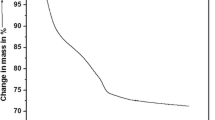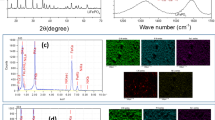Abstract
LiCoPO4 is considered the most interesting positive electrode material. Therefore, 4 different percentages of LiCo1 − xFexPO4 were synthesized by a hydrothermal route at low temperatures. The as-prepared sample has a single orthorhombic Pn21a-phase at 220 °C. As a result, the thermodynamics and combustion process were investigated at numerous rates of heating, and the kinetic parameters were calculated using thermogravimetric experiments. Pyrolysis went to the high-temperature region with an increase in intensity in heating rate, according to the TGA study of the combustions. Three stages were determined according to the TGA analysis, and each stage predicted another phase which was confirmed by XRD. The thermodynamics study of LiCo1 − xFexPO4 materials was an efficient technique to investigate the temperature impact on the pyrolysis activity, which may be beneficial in many contemporary applications. The values of Avrami exponent n(χ) calculated in terms of conversion rate dχ/dt of the first, second, and third conversion peak is 2.22 and 2.95 (for different compositions of LiCo1 − xFexPO4 (0 ≤ x ≤ 20)), respectively. The Impedance spectrum shows that the increase in the Fe content improves the electrical conductivity of LiCoPO4.















Similar content being viewed by others
References
Liu J, et al. Capacity fading mechanisms and state of health prediction of commercial lithium-ion battery in total lifespan. J Energy Storage. 2022;46: 103910.
Miao Y, et al. An overview of global power lithium-ion batteries and associated critical metal recycling. J Hazard Mater. 2022;425: 127900.
Chen T, et al. Experimental research and energy consumption analysis on the economic performance of a hybrid-power gas engine heat pump with LiFePO4 battery. Energy. 2021;214: 118913.
Cui Z, et al. Enhanced electrochemical performance and storage mechanism of LiFePO4 doped by Co, Mn and S elements for lithium-ion batteries. Electrochim Acta. 2021;388: 138592.
Zhuang Y, et al. Influence of the LiFePO4/C coating on the electrochemical performance of Nickel-rich cathode for lithium-ion batteries. J Alloy Compd. 2022;898: 162848.
Islam M, et al. A high voltage Li-ion full-cell battery with MnCo2O4/LiCoPO4 electrodes. Ceram Int. 2020;46(16, Part A):26147–55.
Matsuoka M, et al. Effect of carbon addition on one-step mechanical synthesis of LiCoPO4/C composite granules and their powder characteristics. Ceram Int. 2017;43(1, Part B):938–43.
Di Lecce D, et al. Effect of the iron doping in LiCoPO4 cathode materials for lithium cells. Electrochim Acta. 2015;185:17–27.
Wang Y, et al. Cr-substituted LiCoPO4 core with a conductive carbon layer towards high-voltage lithium-ion batteries. J Solid State Chem. 2018;258:32–41.
Liu Y, et al. Ni-doped LiFePO4/C as high-performance cathode composites for Li-ion batteries. Ceram Int. 2020;46(10, Part A):14857–63.
Li L-J, et al. Inexpensive synthesis of metal-doped LiFePO4 from laterite lixivium and its electrochemical characterization. J Alloy Compd. 2010;497(1):176–81.
Wang Y, et al. AlF3-modified LiCoPO4 for an advanced cathode towards high energy lithium-ion battery. Ceram Int. 2018;44(2):1312–20.
Maeyoshi Y, et al. Effect of conductive carbon additives on electrochemical performance of LiCoPO4. J Power Sources. 2018;376:18–25.
Tolganbek N, et al. Current state of high voltage olivine structured LiMPO4 cathode materials for energy storage applications: a review. J Alloy Compd. 2021;882: 160774.
Zaghib K, Mauger A, Julien CM. Overview of olivines in lithium batteries for green transportation and energy storage. J Solid State Electrochem. 2012;16(3):835–45.
Cheruku R, et al. Electrical relaxation studies of olivine type nanocrystalline LiMPO4 (M=Ni, Mn and Co) materials. J Phys Chem Solids. 2015;86:27–35.
Zhou F, et al. The Li intercalation potential of LiMPO4 and LiMSiO4 olivines with M=Fe, Mn Co, Ni. Electrochem Commun. 2004;6(11):1144–8.
Li Y, Taniguchi I. Facile synthesis of spherical nanostructured LiCoPO4 particles and its electrochemical characterization for lithium batteries. Adv Powder Technol. 2019;30(8):1434–41.
Yu F, et al. Overwhelming microwave irradiation assisted synthesis of olivine-structured LiMPO4 (M=Fe, Mn, Co and Ni) for Li-ion batteries. Nano Energy. 2014;3:64–79.
Chen Y-C, et al. Structure studies on LiMn0.25Fe0.75PO4 by in-situ synchrotron X-ray diffraction analysis. J Power Sources. 2009;189(1):790–3.
Jähne C, et al. A new LiCoPO4 polymorph via low temperature synthesis. J Mater Chem A. 2013;1(8):2856–62.
Kreder Iii KJ, Assat G, Manthiram A. Microwave-assisted solvothermal synthesis of three polymorphs of LiCoPO4 and their electrochemical properties. Chem Mater. 2015;27(16):5543–9.
Brutti S, et al. Controlled synthesis of LiCoPO4 by a solvo-thermal method at 220 °C. Mater Lett. 2015;145:324–7.
Ludwig J, et al. Synthesis and characterization of metastable, 20nm-sized Pna21-LiCoPO4 nanospheres. J Solid State Chem. 2017;248:9–17.
Alarcón-Suesca C, et al. In situ studies and magnetic properties of the Cmcm polymorph of LiCoPO4 with a hierarchical dumbbell-like morphology synthesized by easy single-step polyol synthesis. Inorganics. 2016;4(4):35.
Ludwig J, et al. Direct synthesis and characterization of mixed-valent Li0.5−δCoPO4, a Li-deficient derivative of the Cmcm polymorph of LiCoPO4. RSC Adv. 2017;7(45):28069–81.
Ludwig J, Nilges T. Recent progress and developments in lithium cobalt phosphate chemistry—syntheses, polymorphism and properties. J Power Sources. 2018;382:101–15.
Allen JL, et al. Cr and Si Substituted-LiCo0.9Fe0.1PO4: Structure, full and half Li-ion cell performance. J Power Sources. 2016;327:229–34.
Aboraia AM, et al. Enhancement of the electrochemical performance of LiCoPO4 by Fe doping. Ceram Int. 2021;47(22):31826–33.
Shaaban ER, et al. Crystallization kinetics of new compound of V2O5–PbO–Li2O–Fe2O3 glass using differential thermal analysis. J Alloy Compd. 2009;482(1):440–6.
Goel A, et al. Effect of BaO on the crystallization kinetics of glasses along the Diopside–Ca-Tschermak join. J Non-Cryst Solids. 2009;355(3):193–202.
Kissinger HE. Reaction kinetics in differential thermal analysis. Anal Chem. 1957;29(11):1702–6.
Yang Z, et al. Effects of apparent activation energy in pyrolytic carbonization on the synthesis of MOFs-carbon involving thermal analysis kinetics and decomposition mechanism. Chem Eng J. 2020;395: 124980.
Acknowledgements
The authors extend their appreciation to the Deanship of Scientific Research at King Khalid University for funding this work through the Large Groups Project under grant number (126/43). The authors express their gratitude to Princess Nourah bint Abdulrahman University Researchers Supporting Project (Grant No. PNURSP2023R32), Princess Nourah bint Abdulrahman University, Riyadh, Saudi Arabia.
Author information
Authors and Affiliations
Corresponding author
Additional information
Publisher's Note
Springer Nature remains neutral with regard to jurisdictional claims in published maps and institutional affiliations.
Supplementary Information
Below is the link to the electronic supplementary material.
Rights and permissions
Springer Nature or its licensor (e.g. a society or other partner) holds exclusive rights to this article under a publishing agreement with the author(s) or other rightsholder(s); author self-archiving of the accepted manuscript version of this article is solely governed by the terms of such publishing agreement and applicable law.
About this article
Cite this article
Aboraia, A.M., Hamdalla, T.A., Darwish, A.A.A. et al. Synthesis, the structural and thermal stability of LiCo1 − xFexPO4. J Therm Anal Calorim 148, 3981–3991 (2023). https://doi.org/10.1007/s10973-023-12030-6
Received:
Accepted:
Published:
Issue Date:
DOI: https://doi.org/10.1007/s10973-023-12030-6




